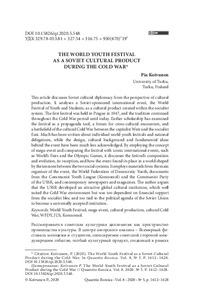The World Youth Festival as a Soviet Cultural Product during the Cold War
Pia Koivunen
https://urn.fi/URN:NBN:fi-fe2021042827210
Tiivistelmä
This article discusses Soviet cultural diplomacy from the perspective of
cultural production. It analyses a Soviet-sponsored international
event, the World Festival of Youth and Students, as a cultural product
created within the socialist system. The first festival was held in
Prague in 1947, and the tradition continued throughout the Cold War
period until today. Earlier scholarship has examined the festival as a
propaganda tool, a forum for cross-cultural encounters, and a
battlefield of the cultural Cold War between the capitalist West and the
socialist East. Much has been written about individual world youth
festivals and national delegations, while the design, cultural
background and fundamental ideas behind the event have been much less
acknowledged. By employing the concept of mega-event and comparing the
festival with iconic international events, such as World’s Fairs and the
Olympic Games, it discusses the festival’s composition and evolution,
its reception, and how the event found its place in a world shaped by
the tensions between the two social systems. It employs materials from
the main organiser of the event, the World Federation of Democratic
Youth, documents from the Communist Youth League (Komsomol) and the
Communist Party of the USSR, and contemporary newspapers and magazines.
The author argues that the USSR developed an attractive global cultural
institution, which well suited the Cold War environment but was too
dependent on financial support from the socialist bloc and too tied to
the political agenda of the Soviet Union to become a universally
accepted institution.
Kokoelmat
- Rinnakkaistallenteet [27094]
